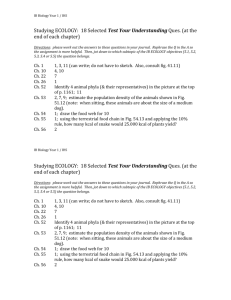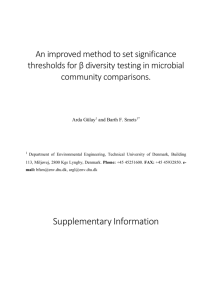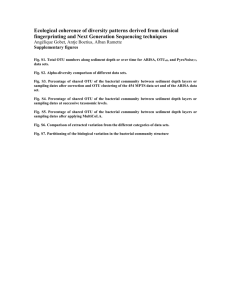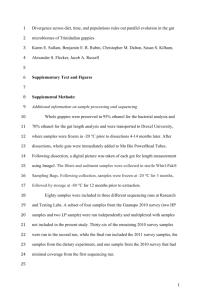Supplementary Figures (doc 945K)
advertisement
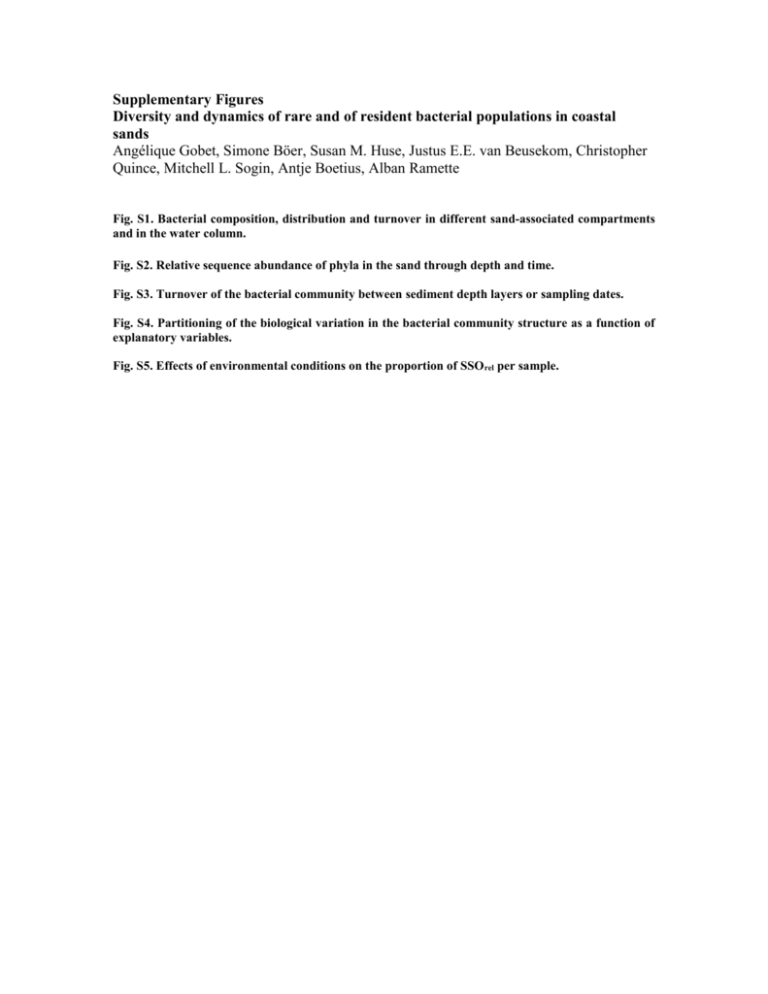
Supplementary Figures Diversity and dynamics of rare and of resident bacterial populations in coastal sands Angélique Gobet, Simone Böer, Susan M. Huse, Justus E.E. van Beusekom, Christopher Quince, Mitchell L. Sogin, Antje Boetius, Alban Ramette Fig. S1. Bacterial composition, distribution and turnover in different sand-associated compartments and in the water column. Fig. S2. Relative sequence abundance of phyla in the sand through depth and time. Fig. S3. Turnover of the bacterial community between sediment depth layers or sampling dates. Fig. S4. Partitioning of the biological variation in the bacterial community structure as a function of explanatory variables. Fig. S5. Effects of environmental conditions on the proportion of SSO rel per sample. Fig. S1. Bacterial composition, distribution and turnover in different sand-associated compartments and in the water column. (A) Rarefaction curves in different compartments of the sand and in the water column at the unique, 3%, 6% and 10% dissimilarities to define OTU. (B) Sequence distribution in different compartments of the sand and in the water column in April 2008. Each bar represents an OTU unique (only OTUunique occurring more than 10 times in the OTUall data set are shown on the skyline plot). The Proteobacteria phylum was separated into its corresponding classes for higher resolution. Gamma, Gammaproteobacteria; Delta, Deltaproteobacteria; Cy, Cyanobacteria; Ba, Bacteroidetes; Alpha, Alphaproteobacteria; Aci, Acidobacteria; Others: Actinobacteria, NA-Proteobacteria (Proteobacteria with class annotation missing), Planctomycetes, Chloroflexi, Verrucomicrobia, WS3, Firmicutes, Lentisphaerae, Deferribacteres, Epsilonproteobacteria, Gemmatimonadetes. (C, D) Total number of shared OTU between the three compartments: Sand grain-associated biofilm, sand porewater, and overlying water column. (C) OTUunique, (D) PyroNoise-corrected OTU3%. Each entire circle represents the total number of OTU in a given compartment (here, one sample). Fig. S2. Relative sequence abundance of phyla in the sand through depth and time. Some of the most abundant phyla were indicated on the first pie chart and in bold in the legend: Gamma, Gammaproteobacteria; Delta, Deltaproteobacteria; Cy, Cyanobacteria; Ba, Bacteroidetes; Alpha, Alphaproteobacteria; Aci, Acidobacteria. The Proteobacteria phylum was separated into its corresponding classes for higher resolution. Unassigned OTUunique were grouped as one phylum in this figure (NA). nd, missing samples. The total number of phyla (including the Proteobacteria divided as classes) is indicated under each pie chart. The legend indicates the phyla color code of the pie charts. Phyla with too few sequences to be visible on the pie charts were removed from the legend: Aquificae, Deinococcus-Thermus, Fibrobacteres, Fusobacteria, Tenericutes, Thermodesulfobacteria and, the candidate divisions: BRC1, JS1, OP10, OP11, OP3, OP5, OPB7, TG1, TM6 and, WS1. Fig. S3. Turnover of the bacterial community between sediment depth layers or sampling dates (A) on the original OTUall data set, (B) after PyroNoise correction of the 454 MPTS data set, at 0% and 3% OTU clustering (PyroNoise0% and PyroNoise3%, respectively), (C) after removing successive percentages of rare OTUunique (1%, 5%, 10%, 15%, 20%, 25%, 30%, 35%, 40%, 45% and 50%) from the OTUall data set by the application of MultiCoLA. The percentage of OTU shared between a sampling depth (or date) and the previous one was calculated and values were represented according to heatmap matrices. OTUall represents the original data set with all OTUunique, used here as a reference to test for the effects of correction and clustering on the resolution of bacterial community dynamics. Fig. S4. Partitioning of the biological variation in the bacterial community structure as a function of explanatory parameters based on (A) the Phylum level, OTUall, resident OTU and SSOrel data sets, and on (B) potential pathogens (including Parachlamydia, Arcobacter, Francisella, Acinetobacter, Rickettsiella, Pseudomonas, Ralstonia). Environmental parameters accounted for included pigments (chlorophyll a and pheophytin), nutrients (silicate, phosphate, nitrite, nitrate, ammonium), extra-cellular enzyme activities (chitinase, α-glucosidase, β-glucosidase, lipase, aminopeptidase, phosphatase), cell abundance and their combined effects. Unexplained variation is not shown. In (A), The black line in each panel separates the pure factor effects from their covariations. Covariation of any of the 4 environmental factors is represented under one category “covariation”. Here, the OTUall level includes also sequences without complete annotation. The total number of sequences in each data set is indicated in parentheses. Fig. S5. Effects of environmental conditions on the proportion of SSOrel per sample. PyroNoisecorrected data were clustered to define OTU at 0% (A, B) and 3% (C, D) sequence dissimilarity levels. The red line in each plot represents the best local fitting regression line between the variables.
